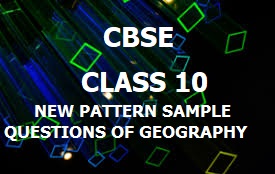Class 10 Geography: New pattern of CBSE sample questions 2023
CBSE sample questions 2023. Before you start solving the questions, you must know that CBSE has introduced a new pattern of questions. The new pattern of class 10 Geography CBSE sample questions 2023 in board exams will emphasize critical thinking, problem-solving, and application of knowledge. Indeed, the aim is to assess the student’s understanding of the subject rather than just their memorization skills.
Again, CBSE sample questions 2023 are going to be in different formats such as multiple choice questions, short answer questions, case studies, projects, practical exams, etc. Moreover, the class 10 CBSE sample questions 2023 may also test the students’ analytical, logical, and creative skills, as well as their ability to apply the concepts they have learned to real-life situations. Therefore, Let’s get started with Geography chapter 1 Resources and Development.
Table Of Contents:
- How to solve CBSE Sample Questions in Board Exams
- MULTIPLE CHOICE QUESTIONS
- ASSERTION AND REASON-BASED QUESTIONS
- FILL IN THE BLANKS
- CAN YOU GUESS WHO AM I?
- Match the Column A with Column B
- Conclusion
How to solve CBSE Sample Questions in Board Exams
To solve CBSE sample questions in board exams, follow these steps:
Read the question carefully
Ensure that you understand what is being asked and what is required from you.
Plan your answer
Take a few moments to think about what you want to say and how you will structure your answer.
Use relevant information and examples
Reference the class textbook and notes, and use relevant information and examples to support your answer.
Write legibly
Write neatly and clearly so that the examiners can read your answer easily.
Check your work
Review your answer to make sure it makes sense, contains all the relevant information, and is free of errors.
Manage your time
Make sure to allocate enough time to each question, so that you can answer all the questions within the given time frame.
Stay calm and focused
Do not panic, stay calm and focused, and give your best effort on each question.
Class 10 Geography: New pattern of CBSE sample questions 2023

MULTIPLE CHOICE QUESTIONS
Q1. Four students are discussing the definition of a resource.
Who do you think is giving the perfect definition?
A. Samir defines resources as technologically accessible, Naturally renewable, and economically feasible.
B. Rehman says a resource must be Renewable, Potential, and Developed.
C. Shreya says, a resource can be defined as “anything which is useful to us is a resource provided it is Biotic, Renewable and belongs to a nation.
D. Shaziya differs from others and defines Everything available in our environment which can be used to satisfy our needs, provided, it is technologically accessible, economically feasible, and culturally acceptable can be termed as a ‘Resource’.
Q2. Find out who has classified the resources on the basis of exhaustibility.
A. Mohit classifies resources as Renewable and Non-renewable.
B. Palak classifies as Biotic and abiotic.
C. Shantanu classifies as Potential, Developed, Stock, and Reserve.
D. Shabana classifies as Individual, Community, National, and International.
Q3. Identify the incorrect statement.
A. All those things which are composed of non-living things are called biotic resources.
B. The resources which can be renewed or reproduced by physical, chemical, or mechanical processes are known as replenishable resources.
C. The country has legal powers to acquire even private property for the public good.
D. Resources is a function of human activities.
Q4. Which of the following statements about the International resource is correct?
i. There are international institutions that regulate some resources.
ii. area beyond 12 nautical miles from the coast of a country is termed an International resource.
iii. India has got the right to mine manganese nodules from the bed of the Indian Ocean.
iv. The oceanic resources beyond 200 nautical miles of the coastline of the country belong to the open ocean and no individual country can utilize these without the concurrence of international institutions.
Options:
A. i, ii and iii
B. ii, iii and iv
C. i, iii and iv
D. i, iii and iv.
Q5. Few students are arguing about the different stages of resource planning.
Who among the following is talking about the second stage of resource planning?
A. David says, identification and inventory of resources across the regions of the country. This involves surveying, mapping, and qualitative and quantitative estimation and measurement of the resources.
B. Bhavesh says Resource Planning is the widely accepted strategy for the judicious use of resources.
C. Aslam says, matching the resource development plans with overall national development plans.
D. Divya says, Evolving a planning structure endowed with appropriate technology, skill and institutional set up for implementing resource development plans.
Class 10 Geography: New pattern of CBSE sample questions 2023
ASSERTION AND REASON-BASED QUESTIONS:
Q5. In the following questions, the Assertions (A) and Reason(s) (R) have been put forward.
Read both statements carefully and choose the correct answer from the below:
Assertion: Sustainable economic development means ‘development should take place without damaging the environment.
Reason: development in the present should not compromise with the needs of future generations.’
(A) If both assertion (A) and reason (R) are true and reason (R) is the correct explanation of the assertion
(B) If both assertion (A) and reason (R) are true but reason (R) is not the correct explanation of assertion (A).
(C) Assertion (A) is true but reason (R) is false.
(D) Both assertion (A) and reason (R) are false.
Social Science Project On Sustainable Development As Per Latest CBSE Guidelines
Q6. Assertion: There are regions that are rich in certain types of resources but are deficient in some other
resources.
Reason: This calls for balanced resource planning at the national, state, regional, and local levels.
(A) both assertion (A) and reason (R) are true and reason (R) is the correct explanation of the assertion
(B) both assertion (A) and reason (R) are true but reason (R) is not the correct explanation of assertion (A).
(C) Assertion (A) is true but reason (R) is false.
(D) Both assertion (A) and reason (R) are false.
Q7. Assertion: Resources can contribute to development only when they are accompanied by appropriate
technological development and institutional changes.
Reason: There are some regions that have a poor resource base but they are economically developed.
(A) If both assertion (A) and reason (R) are true and reason (R) is the correct explanation of the assertion
(B) If both assertion (A) and reason (R) are true but reason (R) is not the correct explanation of assertion (A).
(C) Assertion (A) is true but reason (R) is false.
(D) Both assertion (A) and reason (R) are false.
Q8. Assertion: The cold desert of Ladakh is relatively isolated from the rest of the country.
Reason: It has an abundance of water resources but lacks cultural heritage.
(A) If both assertion (A) and reason (R) are true and reason (R) is the correct explanation of the assertion
(B) If both assertion (A) and reason (R) are true but reason (R) is not the correct explanation of assertion (A).
(C) Assertion (A) is true but reason (R) is false.
(D) Both assertion (A) and reason (R) are false.
Q9. Assertion: Mahatma Gandhi said, “There is enough for everybody’s need and not for anybody’s greed.”
Reason: He was against mass production and wanted to replace it with production by the masses.
(A) If both assertion (A) and reason (R) are true and reason (R) is the correct explanation of the assertion
(B) If both assertion (A) and reason (R) are true but reason (R) is not the correct explanation of assertion (A).
(C) Assertion (A) is true but reason (R) is false.
(D) Both assertion (A) and reason (R) are false.
Q10. Assertion: Total geographical area of India is 32 .08 million sq km.
Reason: Land use data, however, is available only for 9.3 percent of the total geographical area.
(A) If both assertion (A) and reason (R) are true and reason (R) is the correct explanation of the assertion
(B) If both assertion (A) and reason (R) are true but reason (R) is not the correct explanation of assertion (A).
(C) Assertion (A) is true but reason (R) is false.
(D) Both assertion (A) and reason (R) are false.
7 Geography questions from Resources and Development which can trouble class X students
Class 10 Geography: New pattern of CBSE sample questions 2023
FILL IN THE BLANKS
1. The pattern of the net sown area varies greatly from one state to another.
It is over _______ percent of the total area in Punjab and Haryana and less than ____________ percent in Arunachal
Pradesh, Mizoram, Manipur, and Andaman Nicobar Islands.
A. 72 AND 5
B. 80 AND 10
C. 70 AND 30
D. 90 AND 7
2. Forest area in the country is far lower than the desired _________ percent of geographical area,
as it was outlined in the National Forest Policy _________.
A. 27 & 1952
B. 17 & 1972
C. 25 & 1948
D. 33 & 1952
3. In states like Jharkhand, Chhattisgarh, Madhya Pradesh and Odisha deforestation due to _____________ has
caused severe land degradation.
In states like Gujarat, Rajasthan, Madhya Pradesh and Maharashtra __________ are one of the main reasons for
land degradation.
A. Mining & Overgrazing
B. Mining & Over Irrigation
C. Overgrazing & Over Irrigation
D. Overgrazing & Deforestation.
4. Alluvial soils can be classified as old alluvial called ___________ and new alluvial ___________.
A. Khadar & Bangar
B. Bangar & Khadar
C. Red & Yellow
D. Regur and Khadar
5. Soils develop a reddish colour due to _____________of iron in crystalline and metamorphic rocks.
It looks _______________ when it occurs in a hydrated form.
A. Diffusion & Red
B. Presence & Yellow
C. Diffusion & Yellow
D. Hydration & Red
6. Laterite soil is the result of intense _____________ and is more suitable for crops like ____________.
A. Leaching & Cashew nut
B. Humas & Cotton
C. Leaching & Tapioca
D. Erosion & Wheat
7. Ploughing along the contour lines can _______________ the flow of water down the slopes whereas
_______________ have contributed significantly to the stabilization of sand dunes.
A. Decelerate & Terraces B. Accelerate & Shelter belts C. Decelerate & Shelter belts. D. Accelerate & Strip Cropping.
8. The running water cuts through the clayey soils and makes deep channels as ___________. In the Chambal
basin, such lands are called __________________
A. Gullies & Fertile land
B. Gullies & Bad Land
C. Gullies & Ravines.
D. Ravines and Gullies.
Class 10 Geography: New pattern of CBSE sample questions 2023
CAN YOU GUESS WHO AM I?
1. I am the capital city of Brazil where the United Nations Conference on Environment and Development (UNCED), took place in 1992.
2. I am a piece of land that is normally used for farming but is left with no crops on it for two to three years in order to regain my fertility.
3. I am the bottommost layer of the soil profile.
4. You can find me in the Northern plains and the deltas of India. Farmers grow crops on me.
5. I am fertile but develop cracks during hot weather.
6. I develop crystalline igneous rocks in areas of low rainfall. My color changes due to the diffusion of iron in crystalline and metamorphic rocks.
7. I develop under tropical and subtropical climates with alternate wet and dry seasons. I am formed as a result of intense leaching due to heavy rain.
8. Generally river basins are fertile but I make my basin infertile because I cut through the clayey soils and make deep channels as gullies and ravines.
Class 10 Geography: New pattern of CBSE sample questions 2023
Match the Column A with Column B
COLUMN A | COLUMN B |
Fossil Fuels | Biotic |
Metals | Non Renewable |
Fauna | Community Owned |
Burial Grounds | Renewable |
2. Match Column A with Column B
India has land under a variety of relief features, namely; mountains, plateaus, plains, and islands. Based on it, there are questions given in the form of matching the column.
COLUMN A | COLUMN B |
Mountains | 43 Percent |
Plateaus | 93 Percent |
Plains | 27 Percent |
Land use data available | 30 Percent |
3. Match Column A with Column B
Here is a list of states in column A and the reason for Land degradation in column B.
STATE / PLACE | REASON FOR LAND DEGRADATION |
Orissa & Jharkhand | Over Grazing |
Rajasthan & Gujarat | Gullies & Ravines |
Punjab & Haryana | Mining |
Chambal Basin | Water Logging / Over Irrigation |
Class 10 Geography: New pattern of CBSE sample questions 2023
Conclusion:
Overall, the new pattern of CBSE sample questions in board exams is designed to prepare students for the demands of higher education and the 21st-century workforce. Despite this, It helps students to develop a deeper understanding of the subjects they are studying and encourages them to think beyond rote learning. However, for short and long-answer type CBSE sample questions 2023, you can check Resources and Development – Term I Questions and Answers Also do not avoid these 7 Geography questions from Resources and Development which can trouble class X students
Do not forget to comment and share.
You may be interested in
11-Point Project On Consumer Awareness
How to complete your Economics Project On India’s First Digital Currency in 60 minutes





Fabulous notes sir
Big fan of you